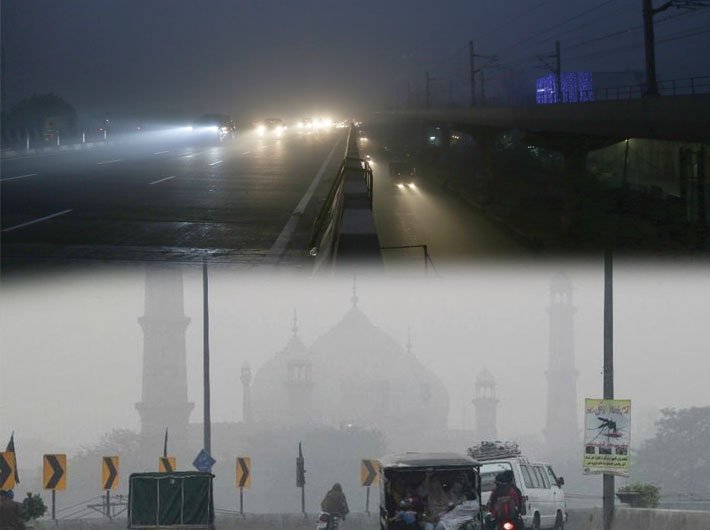There’s a strong case for Indo-Pak cooperation to end air pollution. After all, it’s a matter of millions of citizens’ lives
Main hawa hoon, kahan watan mera? (I’m the wind...do I have a nation to call my own?) Thus goes a famous Urdu ghazal, written by the Indore-born Ameeq Hanafi and soulfully sung by the Hussain brothers of Jaipur. It is immensely popular across both India and Pakistan. The personification of the wind portrays the dilemma of its belongingness: Does the wind belong to a land? Should it seek out its own territory? Today, as parts of north India and eastern Pakistan are enveloped in a toxic haze – air laden with pollutants from millions of vehicles, chullahs, coal-fired power plants, industries and seasonal stubble-burning in the fields in both countries – Hanafi’s verses turn realistic. In total disregard of the differences they have and nurture, the same noxious air hangs over the two countries. Meanwhile, voices are being raised discreetly for the sibling nations to overcome their hatred and come together to deal with this recurring calamity that turns more lethal with every passing year.
Initially, the Pakistanis were blaming the Indian farmers of Punjab and Haryana for burning agricultural waste and causing extreme smog conditions in Pakistan. Not that Pakistan does not have farmers burning their crop waste in breach of prohibitory orders; yet, they would blame India for the smoke from the stubble-burning in large swathes of its fields. However, of late, media and experts in Pakistan have been calling for a more realistic assessment of the situation and seeking cooperation with India to tackle the problem rather than make it another point of contention between them.
According to media reports, this time Lahore (1.11 crore population) and Multan (47.5 lakh population) have been the worst-affected cities of Pakistan. Besides the thick smog posing a huge health hazard, the governments had to shut down power plants as pollutants got deposited on the power lines, plunging a large number of cities and towns into darkness for days. According to media report from Pakistan, 17 power stations had tripped because of unprecedented smog and deposition of pollutants on transmission lines, causing a nearly 12-hour outage in many urban areas of Punjab province. The government had to close 13 power plants that were being run on oil while generation at four other plants had to be curtailed.
Flights had to be cancelled or diverted as visibility remained very poor for a week. The New York Times quoted a rescue department officer, Jam Sajjad Hussain, as saying that the poor visibility had caused over 250 road accidents, killing 14 people and injuring more than 400. In Lahore, about 15,000 patients with serious respiratory problems have been admitted to hospitals. In one Lahore hospital alone 500 patients had been reporting with burning eye and respiratory troubles each day. Doctors have said that, with particulate matter (PM) levels being 30 times higher than normal, the only way out would be the evacuation of the population.
In its editorial, Dawn, the largest circulated English newspaper of Pakistan, says the noxious smog engulfing large parts of upper Punjab is yet another reminder that Pakistan and India have much to talk about beyond geopolitics. The newspaper says: “There is little to nothing that the provincial authorities in Pakistan can do to reduce the intensity of the smog, although much can be done to mitigate its harm, such as issuing alerts and raising awareness about steps that citizens can take to protect themselves from its hazardous effects. In addition, the capacity of public sector hospitals to deal with smog-related respiratory ailments can also be increased. But when it comes to actually dealing with the causes, Pakistan needs a channel of communication open with the Indian government, preferably at the provincial level, to raise the matter formally.”
Soon after this, the environment minister of Pakistan’s Punjab province, Zakia Shah Nawaz Khan, called the smog a regional issue that both India and Pakistan need to collaborate to find a sustainable solution. “The only proper forum to do that at the moment is through the South Asian Association for Regional Cooperation (SAARC). The nature of this emergency is such that let’s say Pakistan effectively tackles smog and India is still struggling, we will, regardless of our efforts, still be affected by air pollution. Hence, it has to be a joint effort,” she said in a statement issued in Lahore.
However, given India’s policy of no talks with Pakistan till it gives up its strategy of using terrorism as a weapon against its neighbour, any meaningful engagement between the two is only a remote possibility. Besides, New Delhi’s efforts to tackle this catastrophe are in disarray – the centre is virtually mum on it and has left the affected states of Delhi, Haryana, Punjab, UP and Rajasthan to deal with it in a piecemeal manner. In this situation, Pakistan’s suggestions are falling on deaf ears in New Delhi. In response to Zakia Shah Nawaz Khan’s statement, Raveesh Kumar, the spokesperson of the ministry of external affairs, has said: “Our stand remains unchanged. For the talks to go ahead there should be a conducive environment which has to be created – an environment has to be created which is free of terrorism and free of terrorists getting support from Pakistan.”
Pakistani scientists are telling anchors in television debates that a major natural reason behind this year’s unprecedented smog in their country has more to do with the Middle East and the Gulf regions than India. It seems the dust-laden winds from the upper strata of the atmosphere of Iran, Kuwait and Saudi Arabia have made their way to India via Pakistan. On reaching Pakistan, where temperature is low, the arid wind absorbs moisture to become heavy and loses momentum. Soon the suspended carbon, sulfates and nitrates released from human activities in both the countries latch on to the heavily moist air and this further bogs down the air as a low-lying toxic cloud. Thus humans breathe these dangerous aerosols (tiny pollutant-moisture particles suspended everywhere in atmosphere); it also clouds the vision. In case of a drastic fall in night temperatures – that happened in Pakistan a week ago – the moisture content of the air increases further and makes the air more lethal for breathing and lowering visibility to virtual zero.
According to the US’s National Aeronautics and Space Administration (NASA), the Indo-Gangetic plains, comprising the river valleys of India, Pakistan, Nepal and Bangladesh, have the haziest skies in this season and the air in these countries remains most polluted during November-January. This makes a case for the Indo-Pak cooperation on tackling this recurring calamity.
NASA, which has a special satellite monitoring the smog and fog, however, says that the smog is not all due to human activity, and is basically a natural phenomenon. A handout of the Earth Observatory of the NASA on its homepage explains the Indian scene: “Air pollution has emerged as a significant issue in India. Satellite observations show that levels of both sulphur dioxide and nitrogen dioxide are rising. A recent World Health Organization analysis of particulate pollution concluded that many of the world’s most polluted cities were in India.” NASA says that globally, the bulk of aerosols (about 90 percent) have natural origins. Volcanoes, for example, eject huge columns of ash into the air, as well as sulphur dioxide and other gases, yielding sulphates. Forest fires send partially burned organic carbon aloft. Certain plants produce gases that react with other substances in the air to yield aerosols. It says: “Sea salt and dust are two of the most abundant aerosols, as sandstorms whip small pieces of mineral dust from deserts into the atmosphere and wind-driven spray from ocean waves flings sea salt aloft. Both tend to be larger particles than their human-made counterparts.” In the current situation, the dust-laden air from Thar desert, running across India and Pakistan, also plays a role, it says.
NASA says the remaining 10 percent of aerosols are considered human-made and they come from a variety of sources. Though less abundant than natural forms, the human-made aerosols can dominate the air downwind of urban and industrial areas.
NASA also quotes Ritesh Gautam of IIT Delhi, an aerosol expert, as saying that the air quality in the Indo-Gangetic plains is linked to its unique geography. “Air masses get hemmed in by the Himalayan mountains in the north and the Vindhya mountains in the south. When temperature inversions occur, all the smoke, dust and industrial pollution entering the atmosphere ends up piling up over the Indo-Gangetic plain because it cannot get over the mountains.”
Therefore, there certainly is a strong case for India and Pakistan to join hands in research, monitoring and co-ordination of efforts to mitigate the suffering of millions of their people year after year.
aasha@governancenow.com
(The article appears in the November 30, 2017 issue)

